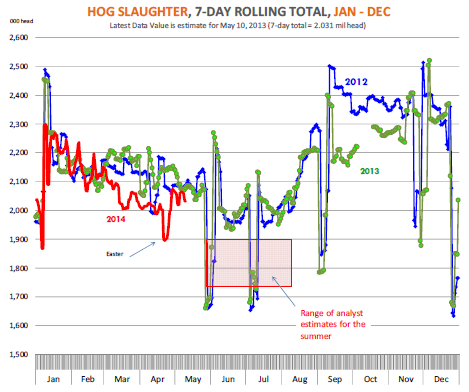



CME: Lean Hog Futures Drifting Lower
US - Lean hog futures have been drifting lower since establishing all time record highs in mid March. Yesterday futures continued to lose ground, with the June contract down as much as 205 points, write Steve Meyer and Len Steiner.Futures declined further in overnight trading and, at least for the moment, the bearish sentiment appears to prevail. There is plenty of speculation as to what’s driving the current pullback in futures. Yesterday there were rumors about the potential bearish impact from labor disruptions in one of the larger pork packing plants in the Midwest.
At this point all we know is what’s reported in media stories and from what’s reported there has been no date announced of a worker strike. Indeed, union speakers quoted in the media pointed out that several steps will be taken before a strike is called.
Other plants are only now starting the negotiation process, which tends to be a fairly lengthy and involved path. We will wait to see how events develop and whether an actual strike is called before delving more into this issue and assessing the potential supply and price impacts.
More important for the futures market, however, is what is happening in terms of pork supplies and the pork sales going into Memorial Day. On the supply front, so far slaughter numbers are only modestly lower from a year ago.
This has provided some assurance for market participants who panicked back in March following several weeks of 6-7 per cent reductions in slaughter. While Monday slaughter was relatively short, slaughter numbers on Tuesday and Wednesday have averaged about 415,000 head.
For the week we still think hog slaughter will remain above 2 million head and about 2.6 per cent lower than a year ago. Weekly slaughter in the past two weeks has been relatively close to the 1 March Hogs and Pigs survey.

The current decline in slaughter has been more than offset by the sharp increase in hog carcass weights. Based on the MPR data on hog weights (LM_HG201 report), average hog weights currently are running at about 217 pounds, 4.8 per cent higher than a year ago.
Average weights of producer owned hogs currently are at 216.8 poudns, +5.2 per cent from a year ago while the average weight of packer owned hogs is hovering at 219.1 pounds, +4.1 per cent vs. last year. These kind of weight gains imply that, at least for the moment, the total supply of pork coming to market is higher than a year ago.

Pork supplies may be higher than a year ago but the sharp spike in prices during March and April as well as fears of a supply shortfall in the summer have caused end users to significantly increase prices. The end user response has been swift and packers have had to lower their offers in order to clear the market.
The more prominent example are bellies. The pork belly cutout was quoted yesterday at $138.37/cwt, 3.5 per cent LOWER than a year ago and 32 per cent lower than where it was just a month ago. The retail market response has been swift and it appears foodservice operators may have changed their plans for bacon features this spring considering speculation of tight supplies.
The pork cutout has declined by about $22 /cwt (-16 per cent) since early April and almost half of the decline is due to the drop in belly values. At this point, the weakness in the pork cutout and higher net pork supplies are keeping hog futures on the defensive.
Market participants will continue to watch closely the progress in daily and weekly slaughter and assess whether the shortfall in slaughter will be large enough to warrant the current premiums in the pork market.








